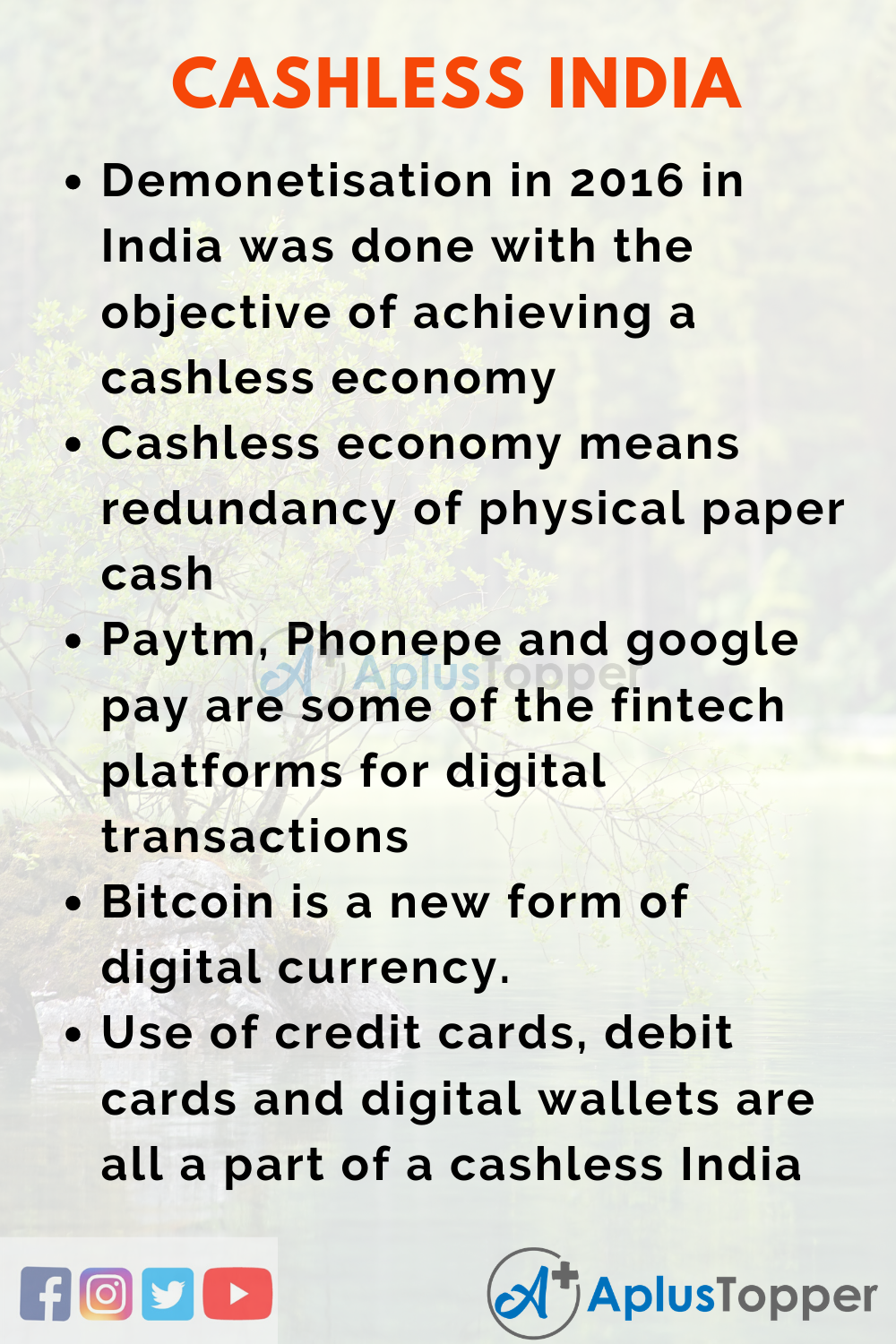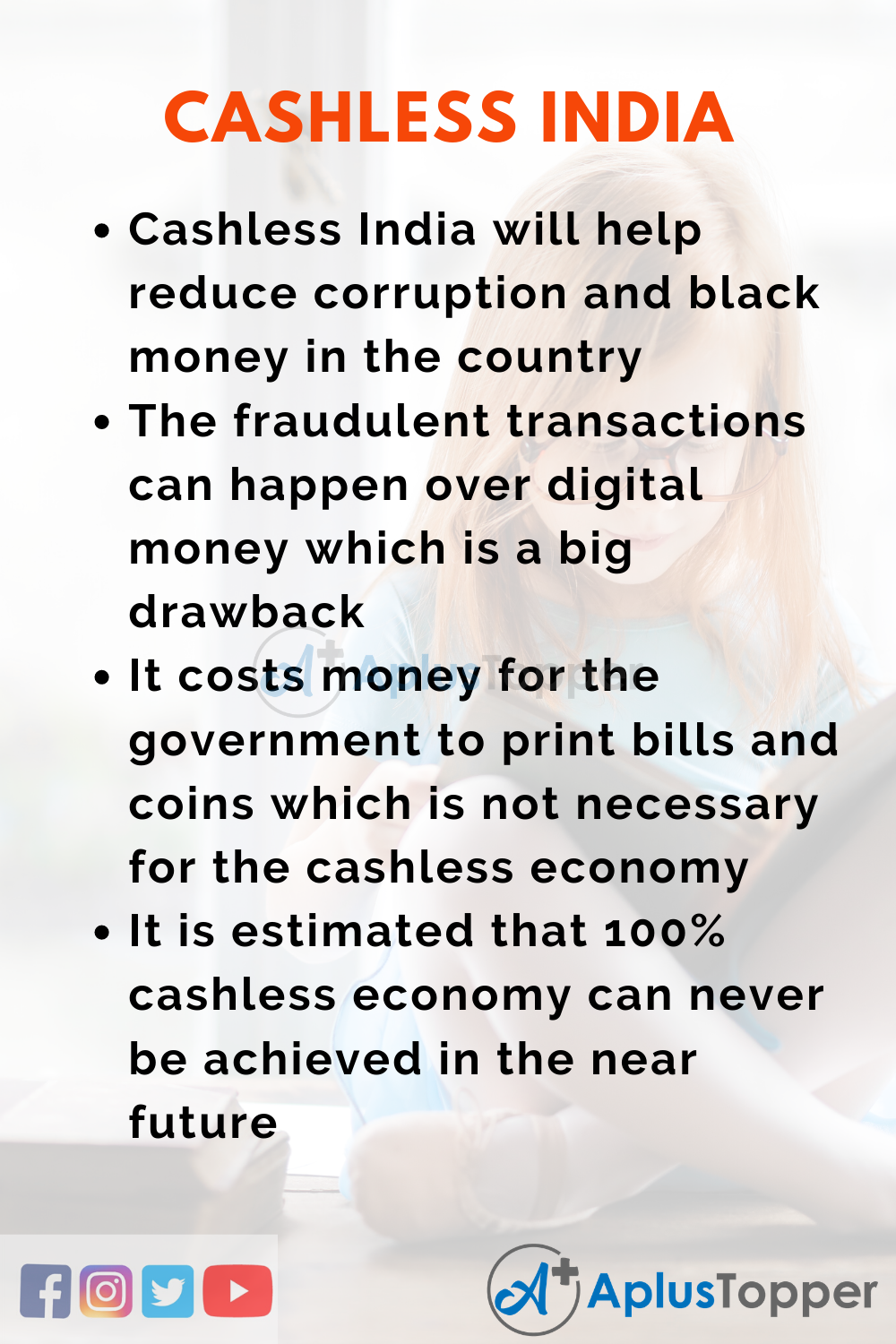Essay on Cashless India: The dream of digital India’s first step is a cashless India. With this dream, on the evening of 8th November 2016 at sharp 8 pm, the Prime Minister of India, Narendra Damodardas Modi announced the demonetisation of Rs. 500 and Rs. 1000 notes in the country. This historic decision was based on various reasons, one of which was a dream of cashless India.
In this essay on cashless India, we will be talking about what it means to be cashless, the various alternatives for our monetary system and what are the advantages and disadvantage for a country which has fully gone digital or cashless in its economy.
You can read more Essay Writing about articles, events, people, sports, technology many more.
Long and Short Essay on Cashless India in English for Students and Kids
In this article, you will find detailed examples of essay on cashless India with a 600-word limit as well as examples of short essay on cashless India with a 200-word limit that students can use in essay writing competition and assignments during these coronavirus holidays.
Long Essay on Cashless India 600 Words in English
The extended essay on cashless India is helpful to students of classes 6,7,8,9 and 10.
The traditional form of monetary transactions with hard physical cash exchanged between people will almost become almost redundant. And this theory has been given an enormous amount of push by the Covid-19 pandemic, given the health concerns in exchanging physical cash. There are plenty of benefits to going cashless. In this essay on cashless India, we shall be talking about both the advantages as well as disadvantages of a cashless India.
First of all, what does a cashless economy mean?
What is the meaning of a Cashless Economy?
A cashless economy means the liquidity in the system is exchanged between two parties through either plastic currency (ATM debit and credit cards) or through digital currency (online payments). With the advent of blockchain technology, bitcoins have given a whole new meaning for a cashless economy. The concept of bitcoin talks about a decentralized system of finance, but that is not the point of discussing in this particular essay on cashless India. Hence, let us come back to the crux of this essay on cashless India, which are the pros and cons of the digital payment system.
Advantages of Cashless India
- Black money will be reduced: Black money is that money that you have earned but not accounted for which means this is that money which is hidden from paying taxes. And this black money is illegal and has the potential of reducing a government to bankruptcy. But the cashless economy will keep a check on black money because, unlike hiding physical cash, you can’t hide digital money, at least not yet. If the technology behind the digital economy is robust and well updated, then governments can track all transactions in the economy which helps in maintaining transparency and authenticity of income.
- Transparency: Corruption in India exists right from Ministerial level to a watchman level, all because of the lack of transparency in our monetary system. Transparency is a big issue in an economy as big as India’s. Corruption scandals in India like CWG or 2g scams or Rafale Jet scams are broken out because of the lack of transparency in transactions. To be frank, a small essay on cashless India will not be enough to talk about all the corruption scandals in India since its independence. Corruptions like these can be reduced to a great extent if the cashless economy is achieved throughout because the biggest advantage of a cashless economy is that the authorities can track and the origin and the endpoint of a transaction easily.
- Easy and simple: With so much technological revolutions happening around, it will be impossible to find someone without a smartphone in this 21st century. Almost every Indian has a smartphone. Hence the ease of transaction through fintech platforms such as Paytm, google pay or phonepe are easier than ever before. The hassles of carrying hard cash( with possible viruses on it) is eliminated. The government of India has produced platforms such as UPI (Unified Payments Interface) for hassle-free cashless transactions.
Disadvantages of Cashless India
- Hacking and Online Theft: As technology is improving every day, so is online fraud and cheating incidents. Unless and until governments have robust and hackproof digital systems, it would be impossible for them to make the economy, especially a country like India with 135 crore population, completely cashless. Incidents of online thefts reported on news channels have made people think twice before making large transactions online.
- Lack of Infrastructure: We are not just talking about government infrastructure but on an individual level as well. You need a gadget (a smartphone), data connectivity and electricity for charging the phones every day to be able to make online transactions often. But these privileges exist mostly in urban India and not in most parts of rural India. Before aiming for the dream of cashless India to come true, governments should take care of these problems.

Short Essay on Cashless India 200 Words in English
The brief essay on cashless India is helpful to students of classes 1,2,3,4,5 and 6.
Cashless economy is the economy in which physical paper cash will become redundant and all the citizens use smartphones and cards to pay for their transactions. But achieving a fully cashless economy needs a lot of up-gradation of digital infrastructure as well as conducting educational and awareness campaigns for people across the country, especially in rural and economically backward areas.
In the view of making India a cashless economy, Prime Minister Narendra Modi had announced demonetisation of Rs. 500 and Rs. 1000 denomination notes from the country in the year 2016. This led to an increase in online cash transaction in the country by 10 folds. But still, India is not a truly cashless economy. Business across the spectrum increasingly adopted cashless transactions in the view of the changing trends in the country, as a result of which many unicorn startups were given birth to, such as Paytm and phonepe in India.
While there are plenty of benefits for a cashless economy like the ease of transaction, curbing corruption and black money, there are many down comings as well. Some of which is lack of trust in digital transactions, hacking and theft frauds. The government should address these problems immediately with proper resources to make India a truly digital and cashless economy.
10 Lines on Essay on Cashless India
- Demonetisation in 2016 in India was done with the objective of achieving a cashless economy
- Cashless economy means redundancy of physical paper cash
- Paytm, Phonepe and google pay are some of the fintech platforms for digital transactions
- Bitcoin is a new form of digital currency
- Use of credit cards, debit cards and digital wallets are all a part of a cashless India
- Cashless India will help reduce corruption and black money in the country
- The fraudulent transactions can happen over digital money which is a big drawback
- It costs money for the government to print bills and coins which is not necessary for the cashless economy
- It is estimated that 100% cashless economy can never be achieved in the near future
- The government needs to build proper digital infrastructure to make a completely cashless economy in a country.

FAQ’s on Essay on Cashless India
Question 1.
What are the types of cashless transactions in India?
Answer:
Cheques, demand drafts, UPI, debit and credit cards, NEFT, RTGS and IMPS are some of the cashless transactions in India
Question 2.
Which country is completely cashless?
Answer:
Sweden has achieved near cashless economy in the world
Question 3.
Is bitcoin a good digital currency?
Answer:
Yes. A decentralized currency like bitcoin is a great form of currency to improve transparency
Question 4.
What are the different digital currencies in the world?
Answer:
Bitcoin, Litecoin, Ehterim are some of the digital currencies in existence as of 2020
